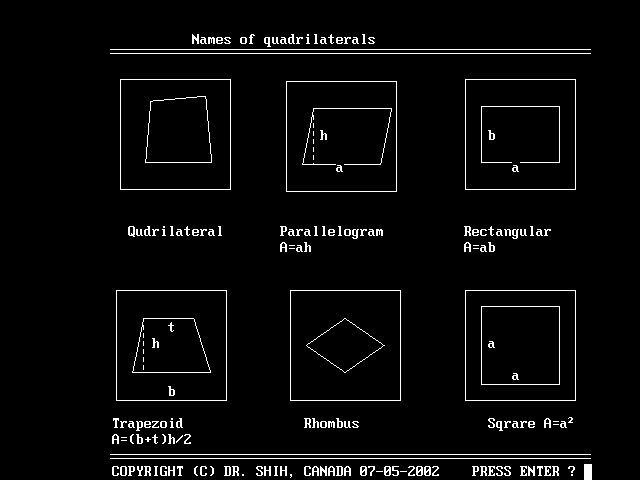Figure 065 : Names of quarilaterals
Q01. Diagram

|
Go to Begin
Q02. Properties of parallelogram
Parallelogram
- 1. Opssosite sides are parallel
- 2. Opssosite sides are parallel and equal
- 3. Opposite angles are equal
- 4. Diagonals bisect each other
- 5. Two neighbour angles are supplemintary
Go to Begin
Q03. Square and rhombus
Squre
- 1. Four sides are equal
- 2. Opssosite sides are parallel and equal
- 3. Each internal angle = 90 degrees
- 4. Diagonals bisect each other and perpendicular each other
- 5. It has 4 symmetrical axis
- Two Side to side perpendicular lines
- Two Veterx to vertex lines
- 1. Four sides are equal
- 2. Opssosite sides are parallel and equal
- 3. Opposite angles are equal
- 4. Each internal angle = 90 degrees
- 5. Diagonals bisect each other but not perpendicular each other
- 6. It has 2 symmetrical axis
Go to Begin
Q04. Rectangle
Go to Begin
Q05. Symmetrical axises of regular polygon
Area of square
- Let side be a
- Area = a^2
- Let side be a and b
- Area = a*b
- Let side be a and one angle be U
- Let diagonals be b and c
- Use cosine law
- b^2 = a^2 + a^2 - 2*a*a*cos(U) = 2*(a^2)*(1 - cos(U))
- c^2 = a^2 + a^2 - 2*a*a*cos(pi - U) = = 2*(a^2)*(1 + cos(U))
- Area
- = b*c
- = 2*(a^2)*Sqr((1 - cos(U))*(1 + cos(U)))
- = 2*(a^2)*Sqr((1 - cos(U)^2))
- = 2*(a^2)*Sqr(sin(U)^2)
- = 2*(a^2)*sin(U)
- Let side be a and one angle be U
- Right angle triangle
- Hypothese = a
- Angle 1 = U/2 and side1 = a*sin(U/2)
- Angle 2 = (pi - U)/2 and side 2 = a*sin(pi/2 - U/2) = a*cos(U/2)
- area = (side 1)*(side 2) = (a^2)*sin(U/2)*cos(U/2) = (a^2)*sin(U)/2
- Area of rhombus = 4*(area of triangle) = 2*(a^2)*sin(U)
- Let sides AB = u and AC = v
- Height h = u*sin(BAC)
- Area = h*v/2 = u*v*sin(A)/2
Go to Begin
Q06. Symmetrical axises of regular polygon
Example 1 : Equal size triangle has 3 symmetrical axese
- From vertex draw line perpendicular to the oppsite side
- Hence we can draw 3 symmetrical axese
- Vertex to vertex
- From vertex draw line perpendicular to the oppsite vertex
- Hence we can draw 2 symmetrical axese
- Side to side
- From mid point of one side draw line to mid point of opposite side
- Hence we can draw another 2 symmetrical axese
- Square can have total 4 symmetrical axese
- 1. Regular Pentagon has 5 symmetrical axese
- 2. Regular Pentagon has 6 symmetrical axese
- Regular polygons : Their sizes are equal.
- Number of symmetrical axes of regular polygon equal to number of sides
- Each internal angle is (n*pi - 2*pi)/n
- Equilateral triangle : Each angle = (3*pi - pi)/3 = 60 degrees
- Square : Each angle = (4*pi - 2*pi)/4 = 90 degrees
- Pentagon : Each angle = (5*pi - 2*pi)/5 = 108 degrees
Go to Begin